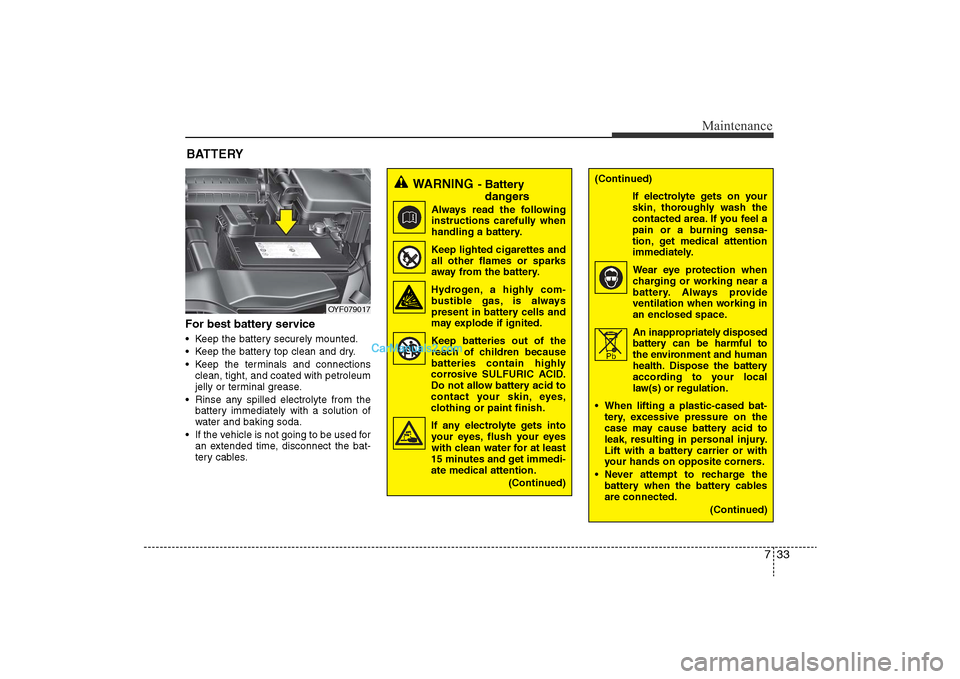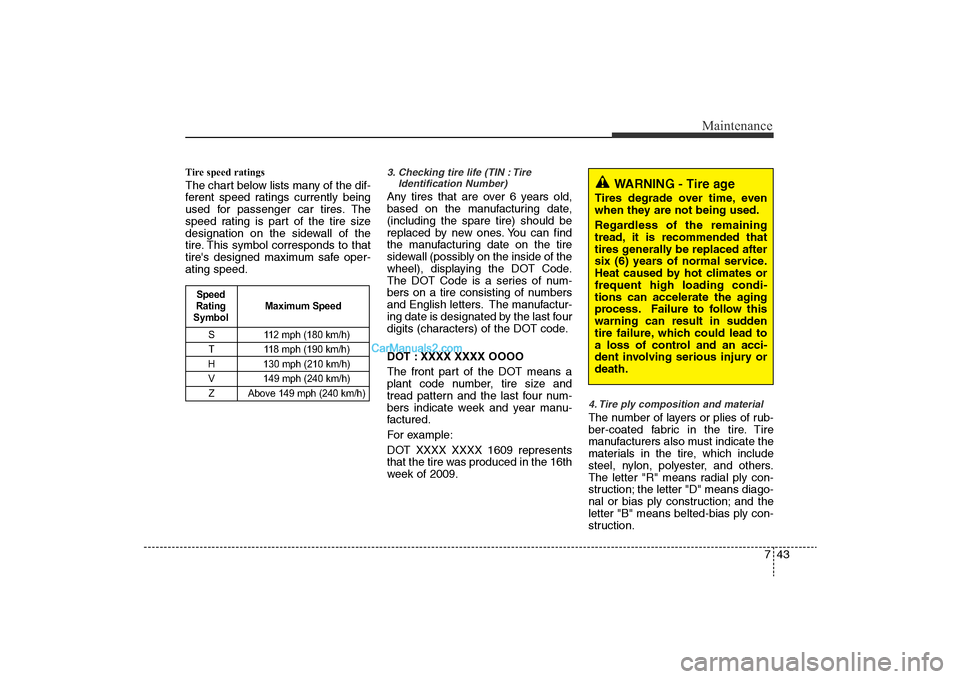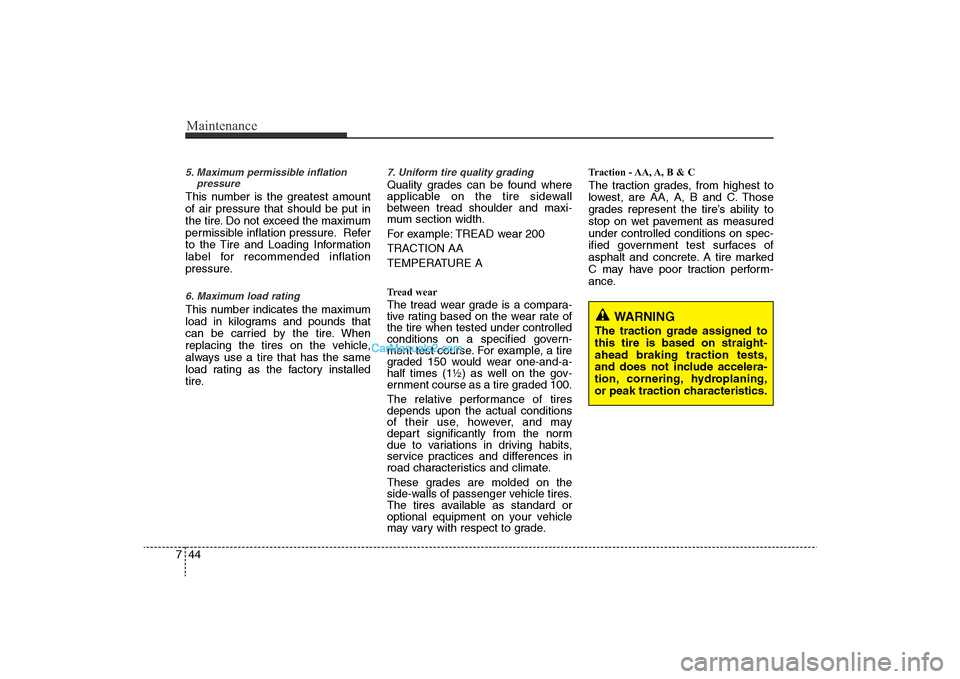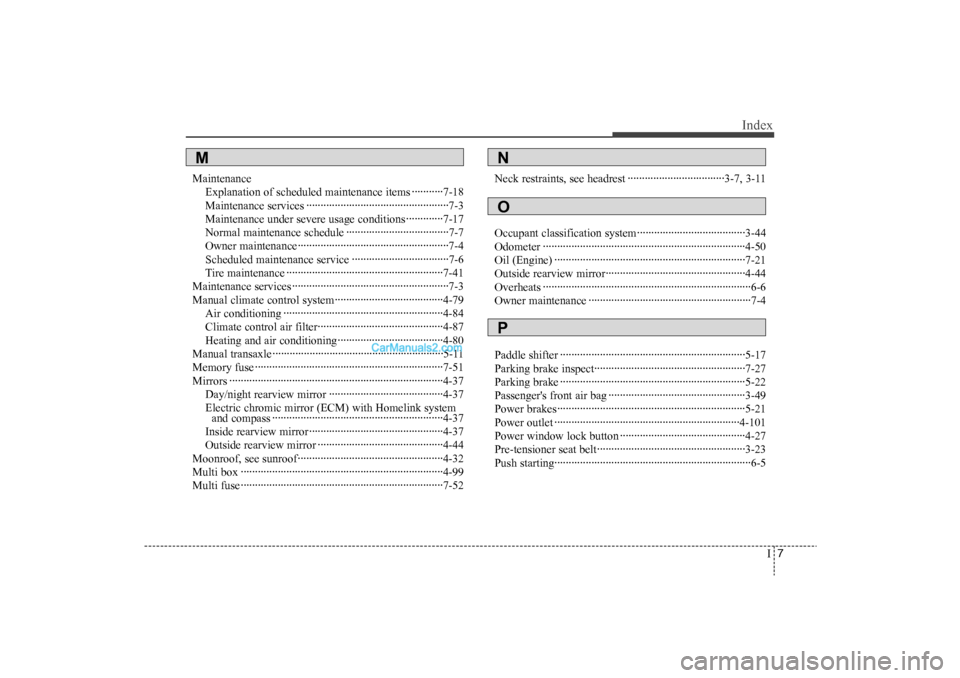2011 Hyundai Sonata service
[x] Cancel search: servicePage 305 of 380

717
Maintenance
MAINTENANCE UNDER SEVERE USAGE CONDITIONSSEVERE DRIVING CONDITIONS
A - Repeatedly driving short distance of less than 5 miles (8 km) in normal tem-perature or less than 10 miles (16 km) in freezing temperature
B - Extensive engine idling or low speed driving for long distances
C - Driving on rough, dusty, muddy, unpaved, graveled or salt- spread roads
D - Driving in areas using salt or other corrosive materials or in very cold weather
E - Driving in sandy areas F - Driving in heavy traffic area over 90°F (32°C)
G - Driving on uphill, downhill, or mountain road
H - Towing a Trailer, or using a camper, or roof rack
I - Driving as a patrol car, taxi, other commercial use or vehicle towing
J - Driving over 106 mph (170 km/h)
K - Frequently driving in stop-and-go conditionsThe following items must be serviced more frequently on cars normally used under severe driving conditions. Refer to the chart
below for the appropriate maintenance intervals.
R : Replace I : Inspect and, after inspection, clean, adjust, repair or replace if neces\
sary
MAINTENANCE ITEM
MAINTENANCE
OPERATION
MAINTENANCE INTERVALS
DRIVING CONDITION
ENGINE OIL AND FILTER
R
EVERY 3,750 MILES (6,000 KM) OR 6 MONTHS
A, B, C, D, E, F, G, H, I, K
AIR CLEANER FILTER
R
MORE FREQUENTLY
C, E
SPARK PLUGS
R
MORE FREQUENTLY
B, H
AUTOMATIC TRANSAXLE FLUID
R
EVERY 60,000 MILES (96,000 KM)
A, C, E, F, G, I
MANUAL TRANSAXLE FLUID
R
EVERY 75,000 MILES (120,000 KM)
A, C, E, F, G, I
FRONT DISC BRAKE/PADS, CALIPERS AND ROTORS
I
MORE FREQUENTLY
C, D, G, H
REAR DISC BRAKE/PADS, PARKING BRAKE
I
MORE FREQUENTLY
C, D, G, H
STEERING GEAR BOX, LINKAGE & BOOTS/
LOWER ARM BALL JOINT, UPPER ARM BALL JOINT
I
MORE FREQUENTLY
C, D, E, F, G, H, I
DRIVE SHAFTS AND BOOTS
I
EVERY 7,500 MILES (12,000 KM) OR 6 MONTHS
C, D, E, F, G, H, I, J
CLIMATE CONTROL AIR FILTER
(FOR EVAPORATOR AND BLOWER UNIT)
R
MORE FREQUENTLY
C, E
YF HMA 7.QXP 11/25/2009 1:45 PM Page 17
Page 321 of 380

733
Maintenance
For best battery service• Keep the battery securely mounted.
• Keep the battery top clean and dry.
• Keep the terminals and connectionsclean, tight, and coated with petroleum
jelly or terminal grease.
• Rinse any spilled electrolyte from the battery immediately with a solution of
water and baking soda.
• If the vehicle is not going to be used for an extended time, disconnect the bat-
tery cables.BATTERY
OYF079017
WARNING
- Battery dangers
Always read the following
instructions carefully when
handling a battery.
Keep lighted cigarettes and all other flames or sparks
away from the battery.
Hydrogen, a highly com- bustible gas, is always
present in battery cells and
may explode if ignited.
Keep batteries out of the reach of children because
batteries contain highly
corrosive SULFURIC ACID.
Do not allow battery acid to
contact your skin, eyes,
clothing or paint finish.
If any electrolyte gets into your eyes, flush your eyes
with clean water for at least
15 minutes and get immedi-
ate medical attention.
(Continued)
(Continued)
If electrolyte gets on your
skin, thoroughly wash the
contacted area. If you feel a
pain or a burning sensa-
tion, get medical attention
immediately.Wear eye protection whencharging or working near a
battery. Always provide
ventilation when working in
an enclosed space.
An inappropriately disposed battery can be harmful to
the environment and human
health. Dispose the battery
according to your local
law(s) or regulation.
• When lifting a plastic-cased bat- tery, excessive pressure on the
case may cause battery acid to
leak, resulting in personal injury.
Lift with a battery carrier or with
your hands on opposite corners.
• Never attempt to recharge the battery when the battery cables
are connected.
(Continued)
Pb
YF HMA 7.QXP 11/25/2009 1:48 PM Page 33
Page 331 of 380

743
Maintenance
Tire speed ratings The chart below lists many of the dif-
ferent speed ratings currently being
used for passenger car tires. The
speed rating is part of the tire size
designation on the sidewall of the
tire. This symbol corresponds to that
tire's designed maximum safe oper-
ating speed.
3. Checking tire life (TIN : TireIdentification Number) Any tires that are over 6 years old,
based on the manufacturing date,
(including the spare tire) should be
replaced by new ones. You can find
the manufacturing date on the tire
sidewall (possibly on the inside of the
wheel), displaying the DOT Code.
The DOT Code is a series of num-
bers on a tire consisting of numbers
and English letters. The manufactur-
ing date is designated by the last four
digits (characters) of the DOT code.
DOT : XXXX XXXX OOOO
The front part of the DOT means a
plant code number, tire size and
tread pattern and the last four num-
bers indicate week and year manu-
factured.
For example:
DOT XXXX XXXX 1609 represents
that the tire was produced in the 16th
week of 2009.
4. Tire ply composition and materialThe number of layers or plies of rub-
ber-coated fabric in the tire. Tire
manufacturers also must indicate the
materials in the tire, which include
steel, nylon, polyester, and others.
The letter "R" means radial ply con-
struction; the letter "D" means diago-
nal or bias ply construction; and the
letter "B" means belted-bias ply con-
struction.
S 112 mph (180 km/h)
T 118 mph (190 km/h)
H 130 mph (210 km/h) V 149 mph (240 km/h)Z Above 149 mph (240 km/h)
Maximum Speed
Speed
Rating
Symbol
WARNING - Tire age
Tires degrade over time, even
when they are not being used.
Regardless of the remaining
tread, it is recommended that
tires generally be replaced after
six (6) years of normal service.
Heat caused by hot climates or
frequent high loading condi-
tions can accelerate the aging
process. Failure to follow this
warning can result in sudden
tire failure, which could lead to
a loss of control and an acci-
dent involving serious injury or
death.
YF HMA 7.QXP 11/25/2009 1:48 PM Page 43
Page 332 of 380

Maintenance44
75. Maximum permissible inflation
pressureThis number is the greatest amount
of air pressure that should be put in
the tire. Do not exceed the maximum
permissible inflation pressure. Refer
to the Tire and Loading Information
label for recommended inflation
pressure.6. Maximum load ratingThis number indicates the maximum
load in kilograms and pounds that
can be carried by the tire. When
replacing the tires on the vehicle,
always use a tire that has the same
load rating as the factory installed
tire.
7. Uniform tire quality grading Quality grades can be found where
applicable on the tire sidewall
between tread shoulder and maxi-
mum section width.
For example: TREAD wear 200
TRACTION AA
TEMPERATURE ATread wearThe tread wear grade is a compara-
tive rating based on the wear rate of
the tire when tested under controlled
conditions on a specified govern-
ment test course. For example, a tire
graded 150 would wear one-and-a-
half times (1½) as well on the gov-
ernment course as a tire graded 100.
The relative performance of tires
depends upon the actual conditions
of their use, however, and may
depart significantly from the norm
due to variations in driving habits,
service practices and differences in
road characteristics and climate.
These grades are molded on the
side-walls of passenger vehicle tires.
The tires available as standard or
optional equipment on your vehicle
may vary with respect to grade.
Traction - AA, A, B & C The traction grades, from highest to
lowest, are AA, A, B and C. Those
grades represent the tire’s ability to
stop on wet pavement as measured
under controlled conditions on spec-
ified government test surfaces of
asphalt and concrete. A tire marked
C may have poor traction perform-
ance.
WARNING
The traction grade assigned to
this tire is based on straight-
ahead braking traction tests,
and does not include accelera-
tion, cornering, hydroplaning,
or peak traction characteristics.
YF HMA 7.QXP 11/25/2009 1:48 PM Page 44
Page 349 of 380

761
Maintenance
Rear combination light bulb
replacement(1) Back-up light
(2) Tail light
(3) Rear turn signal light
(4) Stop and tail light
(5) Side marker
Rear turn signal, stop and tail light,side marker1. Open the trunk lid.
2. Remove the service cover by pulling out the service cover. 3. Remove the socket from the assembly
by turning the socket counterclockwise
until the tabs on the socket align with
the slots on the assembly.
4. Remove the bulb from the socket by pressing it in and rotating it counter-
clockwise until the tabs on the bulb
align with the slots in the socket. Pull
the bulb out of the socket.
5. Insert a new bulb by inserting it into the socket and rotating it until it locks
into place.
6. Install the socket in the assembly by aligning the tabs on the socket with the
slots in the assembly. Push the socket
into the assembly and turn the socket
clockwise.
7. Install the service cover by putting it into the service hole.
Back-up lightIf the light is not operating, have the vehi-
cle checked by an authorized HYUNDAI
dealer.
OYF079042N
OYF079035
OYF079043
YF HMA 7.QXP 11/26/2009 10:55 AM Page 61
Page 365 of 380

Specifications, Consumer information, Reporting safety defeccts4
8RECOMMENDED LUBRICANTS AND CAPACITIES To help achieve proper engine and powertrain performance and durability, use only lubricants of the proper quality. The correct
lubricants also help promote engine efficiency that results in improved fuel economy.These lubricants and fluids are recommended for use in your vehicle.*1Refer to the recommended SAE viscosity numbers on the next page.
*2Engine oils labeled Energy Conserving Oil are now available. Along with other additional benefits, they contribute to fuel econo my by reducing
the amount of fuel necessary to overcome engine friction. Often, these improvements are difficult to measure in everyday driving , but in a year’s
time, they can offer significant cost and energy savings.
*3If the API service SM engine oil is not available in your country, you are able to use API service SL.
Lubricant
Volume
Classification
Engine oil
*1 *2
(drain and refill)
Recommends
4.86 US qt. (4.6
l)
API Service SM*
3,
ILSAC GF-4 or above
Manual transaxle fluid
1.90 US qt. (1.8
l)
API GL-4, SAE 75W/85
Automatic transaxle fluid
7.50 US qt. (7.1
l)
MICHANG ATF SP-IV, SK ATF SP-IV
NOCA ATF SP-IV, HYUNDAI genuine ATF SP-IV or other brands meeting the above specification approved by Hyundai Motor Co.,
Coolant
6.97 US qt. (6.6
l)
Mixture of antifreeze and water (Ethylene glycol basecoolant for aluminum radiator)
Brake/clutch fluid
0.7~0.8 US qt.
(0.7~0.8
l)
FMVSS116 DOT-3 or DOT-4
Fuel
18.49 US gal. (70
l)
Unleaded gasoline
YF HMA 8.QXP 12/24/2009 5:23 PM Page 4
Page 366 of 380

85
Specifications, Consumer information, Reporting safety defeccts
Recommended SAE viscosity
number
Engine oil viscosity (thickness) has an
effect on fuel economy and cold weather
operating (engine start and engine oil
flowability). Lower viscosity engine oils
can provide better fuel economy and cold
weather performance, however, higher
viscosity engine oils are required for sat-
isfactory lubrication in hot weather. Using
oils of any viscosity other than those rec-
ommended could result in engine dam-
age.When choosing an oil, consider the range
of temperature your vehicle will be oper-
ated in before the next oil change.
Proceed to select the recommended oil
viscosity from the chart.
CAUTION
Always be sure to clean the area
around any filler plug, drain plug, ordipstick before checking or drain- ing any lubricant. This is especiallyimportant in dusty or sandy areasand when the vehicle is used on unpaved roads. Cleaning the plugand dipstick areas will prevent dirt and grit from entering the engineand other mechanisms that could be damaged.
Temperature Range for SAE Viscosity Numbers
Temperature
Engine Oil *
1°C
(°F)
-30 -20 -10 0 10 20 30 40 50 -10 0 20 40 60 80 100 120
1. For better fuel economy, it is recommended to use the engine oil of a viscosity grade SAE 5W-
20 (API Service SM / ILSAC GF-4). However, if the engine oil is not available, select the prop-
er engine oil using the engine oil viscosity chart.
10W-30
5W-20, 5W-30
YF HMA 8.QXP 12/24/2009 5:23 PM Page 5
Page 377 of 380

I7
Index
MaintenanceExplanation of scheduled maintenance items ···········7-18
Maintenance services ··················\
··················\
··············7-3
Maintenance under severe usage conditions ·············7-17
Normal maintenance schedule ··················\
··················\
7-7
Owner maintenance··················\
··················\
·················7-4
Scheduled maintenance service ··················\
················7-6
Tire maintenance ··················\
··················\
··················\
·7-41
Maintenance services ··················\
··················\
··················\
·7-3
Manual climate control system··················\
··················\
··4-79 Air conditioning ··················\
··················\
··················\
··4-84
Climate control air filter··················\
··················\
········4-87
Heating and air conditioning··················\
··················\
·4-80
Manual transaxle ··················\
··················\
··················\
······5-11
Memory fuse ··················\
··················\
··················\
············7-51
Mirrors ··················\
··················\
··················\
··················\
···4-37 Day/night rearview mirror ··················\
··················\
····4-37
Electric chromic mirror (ECM) with Homelink systemand compass ··················\
··················\
··················\
······4-37
Inside rearview mirror··················\
··················\
···········4-37
Outside rearview mirror ··················\
··················\
········4-44
Moonroof, see sunroof··················\
··················\
···············4-32
Multi box ··················\
··················\
··················\
·················4-99\
Multi fuse ··················\
··················\
··················\
·················7-52\
Neck restraints, see headrest ··················\
················3-7, 3-1\
1
Occupant classification system··················\
··················\
··3-44
Odometer ··················\
··················\
··················\
·················4-50\
Oil (Engine) ··················\
··················\
··················\
·············7-21
Outside rearview mirror··················\
··················\
·············4-44
Overheats ··················\
··················\
··················\
··················\
·6-6
Owner maintenance ··················\
··················\
··················\
···7-4
Paddle shifter ··················\
··················\
··················\
···········5-17
Parking brake inspect··················\
··················\
·················7-27\
Parking brake ··················\
··················\
··················\
···········5-22
Passenger's front air bag ··················\
··················\
············3-49
Power brakes··················\
··················\
··················\
············5-21
Power outlet ··················\
··················\
··················\
···········4-101
Power window lock button ··················\
··················\
········4-27
Pre-tensioner seat belt··················\
··················\
················3-23
Push starting··················\
··················\
··················\
···············6-5M
NOP
YF HMA INDEX.QXP 1/13/2010 2:11 PM Page 7